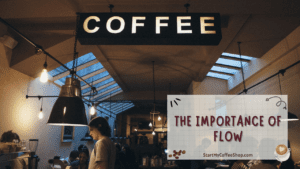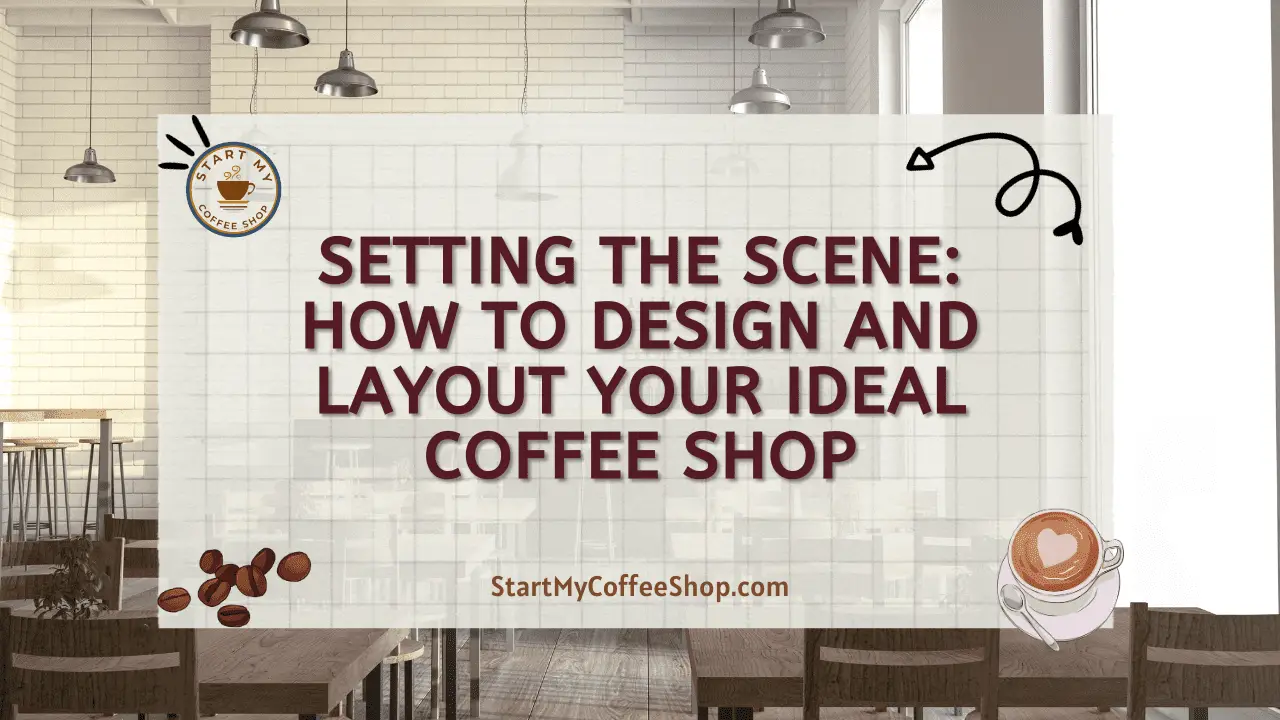The design and layout of a coffee shop is a sensitive and multidimensional process that necessitates careful consideration of numerous elements. Every component plays a critical part in determining the entire experience.
To best design and layout your coffee shop, you should take into account the theme, target audience, and flow. Optimize seating, counter, and bar placement, giving importance to aesthetics, functionality, and comfort.
In this article, we will look at the essential components that contribute to the best design and layout for your coffee shop, assisting you in creating a productive and memorable business.
Understanding Your Theme and Brand Identity

The first and possibly most important stage in the process of creating your coffee shop is to decide on a unifying theme and create a unique brand identity. The theme of your coffee shop acts as the center and inspiration for the entire establishment, defining its personality and distinguishing it from rivals in the crowded coffee market.
It is crucial to delve into the specifics of your coffee shop’s personality and vision to do this. Investigate the numerous components that go into the atmosphere and experience as a whole. Take pleasure in the details of decor, taking into account items like furniture designs, wall art, and ornamental accessories that reflect your intended concept. Will your coffee business radiate the sleek and futuristic vibe of a modern, minimalist sanctuary or will it enjoy the warm embrace of a rustic, comfortable cabin?
The color scheme you select is key to establishing the atmosphere and tone of your coffee business. Colors can evoke feelings and produce a particular ambiance. For instance, warm and earthy hues like browns and deep greens convey a feeling of security and a sense of being rooted, but bright and lively colors evoke vigor and life. Choose a color scheme that goes well with your theme and appeals to your target audience to improve their experience.
The lighting in coffee shops is a sometimes disregarded but hugely important design element. The use of light can highlight certain elements, arouse particular feelings, and designate particular areas within the coffee shop. The lighting design should blend with the chosen theme, enhancing the entire mood, whether it’s warm and low lighting to foster closeness or bright and natural lighting to inspire productivity.
Read more about: Small Coffee Stand Business Plan: Small but Mighty
Identifying Your Target Audience
The key to designing a coffee shop that has a profound impact on its customers is to comprehend and connect with your target demographic. An essential instrument for doing this is rigorous market research, which gives you invaluable knowledge about the tastes and passions of your potential customers.
Finding the precise demographic you want to target is the first step in starting this journey of discovery. Are you trying to draw in those who are studying or working remotely and are looking for a quiet place to focus on their work or studies? Alternatively, perhaps you picture your coffee shop as a buzzing social hub that attracts young people looking for a fun environment to relax and connect.
Market research explores the reasons and aspirations that influence your target audience’s decision-making. When planning the layout and design of your coffee shop, take into account the customers’ lifestyles, hobbies, and habits. Prioritize providing quiet nooks and hidden seating locations if your audience values seclusion and focus. On the other side, if your goal is to serve a social and active audience, concentrate on creating a communal environment with group seats and engaging features.
The atmosphere and ambiance you create should speak to the emotional demands of your target audience in addition to the physical aspects of design. Choose soothing background music and a gentle color scheme for a tranquil setting that promotes a state of calm and introspection. Consider playing energetic music and using colorful, vibrant furnishings to create a social and active atmosphere that radiates excitement and togetherness.
Optimizing Seating Arrangements
An essential component of coffee shop design, the seating arrangement has a big impact on how customers feel about the place. To accommodate a variety of tastes, aim for a well-balanced combination of seating alternatives. Offer solitary tables for people who want some peace, while communal tables encourage a sense of community and interaction. Solo customers have quick and easy access to bar stools at the counter, and comfortable lounge sections are available for those who want to relax and stay a while.
Prioritizing comfort is essential, as is making ensuring that seating is properly positioned to accommodate different group sizes, including single people, couples, and larger groups. There is plenty of space between tables to allow for a smooth flow, avoiding traffic jams during peak times. The clever seating arrangement makes your coffee shop a friendly and inclusive environment for everyone.
Strategic Counter and Bar Placement
For a coffee shop to work well and provide a positive client experience, the counter and bar area are crucial. To make a positive first impression as consumers enter the store, the counter must be positioned carefully. The welcome atmosphere is enhanced and clients are encouraged to approach and place their purchases in comfort by making sure that they are easily visible and accessible when they enter the store.
Smooth and effective customer service should be prioritized in the design of this space. To create drinks easily and make the ordering procedure smooth and enjoyable for customers, baristas require enough room. By avoiding a crowded counter, baristas can work quickly and provide top-notch service while also avoiding any claustrophobia among both employees and clients.
The Importance of Flow

The customer experience in a coffee shop can be made or broken by the flow of the design. Customers can easily explore the area thanks to a carefully thought-out layout, which promotes a feeling of ease and comfort. Customers may concentrate on enjoying their coffee and chatting by avoiding crowds and confusion, which improves the atmosphere overall.
It is crucial to take into account the typical traffic patterns that develop inside the coffee shop to create a smooth flow. To handle the ebb and flow of clients during peak hours and avoid bottlenecks and congestion, strategically place furniture and fixtures. This careful approach improves consumer happiness while simultaneously maximizing staff productivity, allowing baristas to serve customers efficiently.
A well-executed flow in your coffee shop design gives the whole experience a sense of flow, boosting the pleasure of enjoying a cup of coffee and cultivating a setting that inspires customers to visit frequently. Your coffee shop becomes a haven for customers looking for a warm and pleasurable location to sip their favorite brews with a layout that encourages movement and ease.
Read more about: Start A Coffee Business: An Introduction For Beginners
Aesthetics for Ambiance
Aesthetics are at the core of creating a welcoming atmosphere in your coffee shop that draws consumers in right away. A significant impact on the overall experience may be made by thoughtfully choosing the colors, lighting, and decor. It’s crucial to match these components with your selected theme and target audience if you want to create a unified and inviting ambiance.
Setting the perfect mood with your color choices affects the entire environment. Visitors are enveloped in a snug embrace by warm and earthy colors like soothing browns and rich greens, which promotes relaxation and peace. Contrarily, energetic and lively hues provide life and vibrancy, producing a dynamic and energizing setting.
A balanced approach is essential when it comes to lighting because it is so important for boosting mood. A warm and welcoming glow is produced when artificial and natural light is balanced, putting clients at ease. The right lighting enhances the interior design and creates the right atmosphere, making your coffee shop into a seductive haven for coffee connoisseurs.
Functionality for Efficiency
Although practicality is the foundation for the smooth running of the entire establishment in the complex world of coffee shop design, aesthetics may draw the eye. Without an equally effective plan that meets the demands of both workers and customers, a beautiful atmosphere is pointless.
Your coffee shop’s layout should put efficiency first, making it simple for consumers to find their way around and take advantage of the coffee experience. Customers must have easy access to key locations including the counter, bathrooms, and self-service stations. Customers can easily approach the counter by placing it in a prominent, central place, which facilitates easy ordering and pickup procedures.
The way the room is set up will play an equally important role in streamlining staff and baristas’ workflow. Take into account the regular client flow and everyday routine during busy times. Reduce bottlenecks and potential interruptions by placing furniture, counters, and service areas in strategic locations. This well-planned arrangement maximizes employee productivity, guaranteeing rapid and effective customer service.
Customers’ comfort is taken into account in the practical design, which includes plenty of room for seats and moving. To encourage customers to linger and enjoy their time at your coffee shop, do not overcrowd or cram the area. Customers are more likely to choose your coffee shop as their favorite destination when the seating arrangements and table spacing are comfortable and well done.
Comfort and Seating Ergonomics
When it comes to the layout of coffee shops, providing a relaxing environment for customers is of the utmost importance because it has the potential to improve the overall experience. Investing in high-quality, ergonomic chairs is a certain method to make customers feel appreciated and entice them to cherish their coffee moments with unhurried delight.
The selection of seats is one of the most important factors in producing a welcoming and comfortable ambiance. Seating that is ergonomically designed not only helps to maintain the body’s natural posture but also makes sure that consumers are comfortable throughout their visit. Guests are more likely to stay when the sitting is comfortable, which helps create an atmosphere that is more like being at home away from home.
Consider introducing soft sofas and armchairs that engulf clients in a warm embrace into the design of the space to provide an atmosphere that promotes relaxation. These quaint crannies provide those who are looking for tranquility tranquil havens, as well as close friends looking for intimate areas in which to catch up over a cup of coffee. The availability of comfy seating alternatives has a purpose beyond that of simple utility; it helps to cultivate an emotional connection between the patrons of your coffee shop and your establishment.
The attractiveness of comfy sitting extends beyond the limits of your coffee shop and into other public spaces. People who have a good time at your coffee shop are more likely to tell their friends and family about it, which will bring in new customers who are looking for the same kind of coziness and warmth that they experienced there.
Frequently Asked Questions

What elements should I take into account when constructing a coffee shop?
Take into account the theme, intended market, and spatial flow while building a coffee shop. Place the counters, bars, and seating strategically to facilitate efficient client service. To create a welcoming atmosphere, give aesthetics, functionality, and comfort top priority.
How can I attract my ideal clientele at a coffee shop?
Conduct market research to learn your target audience’s preferences to appeal to them. Adapt the coffee shop’s layout, furnishings, and menu to their unique requirements and preferences. Make a consistent brand identity that appeals to your target audience.
What part does flow play in the design of a coffee shop?
A coffee shop’s design must consider flow because it affects the overall consumer experience. Customers may easily navigate a layout that has been carefully thought out, which reduces traffic at peak times. It increases employee productivity, resulting in a more comfortable and effective atmosphere for both consumers and employees.
To learn more on how to start your own coffee shop, check out my startup documents here.
Disclaimer: The information provided by StartMyCoffeeShop.com (“The Site”) is for general informational purposes only. All information on the Site is provided in good faith. However, we make no representation or warranty of any kind, express or implied, regarding the accuracy, adequacy, validity, reliability, availability, or completeness of any information on the Site. Under no circumstance shall we have any liability to you for any loss or damage of any kind incurred as a result of the use of the Site or Reliance on any information provided on the Site. Your use of the Site and reliance on any information on the Site is solely at your own risk. This blog post is for educational purposes only and does not constitute legal advice. Please consult a legal expert to address your specific needs. Terms and Conditions. (https://startmycoffeeshop.com/terms-and-conditions/)

Hi! I’m Shawn Chun
My adventure in coffee began when I first launched my first coffee shop back in the early 2000s. I had to figure out so many things on my own and to make it worse within 2 years of opening two large corporate coffee chains moved in just blocks away from me!
As I saw smaller and even some larger coffee shops in the neighborhood slowly lose customers to these giant coffee chains and slowly close up shop, I knew that I had to start getting creative…or go out of business.
I (like you may be) knew the coffee industry well. I could make the best latte art around and the foam on my caps was the fluffiest you have ever seen. I even had the best state-of-the-art 2 group digital Nuova Simonelli machine money could buy. But I knew that these things alone would not be enough to lure customers away from the name brand established coffee shops.
Eventually, through lots of trial and error as well as perseverance and creativity I did find a way to not only survive but also thrive in the coffee/espresso industry even while those corporate coffee chains stayed put. During those years I learned to adapt and always faced new challenges. It was not always easy, however, in the end, I was the sole survivor independent coffee shop within a 10-mile radius of my location. Just two corporate coffee chains and I were left after that year. All told the corporate coffee chains took down over 15 small independent coffee shops and kiosks and I was the last one standing and thriving.
Along the years I meet others with the same passion for coffee and I quickly learned that it is not only “how good a barista is” that makes a coffee shop successful, but the business side of coffee as well.
Hence why I started this website you are on now. To provide the tools and resources for up and coming coffee shop owners to gain that vital insight and knowledge on how to start a coffee shop successfully.
Stick around, browse through my helpful blog and resources and enjoy your stay! With lots of LATTE LOVE!
Shawn







